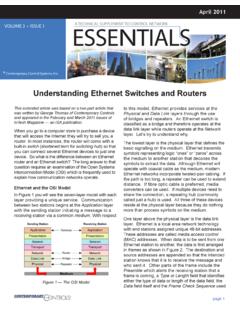Transcription of Designing and Implementing a Successful Business …
1 Designing and Implementing a Successful Business model A G U IDE F O R T H E C-S UITE E XE CUTIVE. Designing and Implementing a Successful Business model : A Guide for the C-Suite Executive Copyright 2016. All rights reserved. Except as permitted under Copyright Act of 1976, no part of this publication may be reproduced, distributed, or transmitted in any form or by any means, or stored in a database or retrieval system, without the prior written permission of the publisher. 2 Designing and Implementing a Successful Business model : A Guide for the C-Suite Executive Table of Contents 4 Introduction 5 Chapter 1: The Elements of Success in Today's Dynamic Market 9 Chapter 2: Aligning Limited Resources for the Things That Matter 13 Chapter 3: Making Hard Choices within the Organization 17 Chapter 4: Ensuring Organization Design Effectiveness 20 Chapter 5: Sealing the Deal on Post-Implementation Performance 23 Chapter 6.
2 Finding the Right Change Partner 25 Conclusion 3 designing and implementing a successful business model : A Guide for the C-Suite Executive Introduction Imagine you are building your dream home. You have a vision of what it will look like and how it will function. But how do you get from vision to reality? How do you determine what needs to be done? How do you coordinate all the elements of construction making sure nothing gets missed along the way? Most importantly, what's needed to stay within the budget and on schedule?
3 Although this isn't a guide for building a house, the metaphor is useful when talking about Designing and Implementing a differentiated Business model . You have a vision for your Business and how you will serve your customers. That strategic vision plays out in your Business model . Your Business model details what problem you will solve for your customers and how you will do so in a distinctive way that will ensure a profitable bottom line. But practically speaking, how will you create an organization that will allow you to solve that problem for your customers?
4 That's where an aligned organization design comes in. It aligns the various aspects of your Business to compete effectively. This is hard work, and a real challenge for executives today. In this guide, you'll learn how to translate your strategy into a differentiated Business model and align your organization's design to deliver to your customers. You'll also learn how to adjust and realign your organization in response to ever-changing marketplace conditions. 4 Designing and Implementing a Successful Business model : A Guide for the C-Suite Executive CHAPTER 1.
5 The Elements of Success in Today's Dynamic Market How do you know if you have a good Business model ? In simple terms, you'll know if it solves a problem for your customer. Obviously there's more to it than that. Your Business model conceptualizes how your organization will create value for customers. There are three elements that need to be in alignment when developing an effective and differentiated Business model . 1. Clarity around the market (and your customer's expectations). 2. A Business model that uniquely delivers value to customers and produces a return for your company 3.
6 An aligned organization design that puts the right resources, talent and focus on the activities that matter most to the customer. Let's start with the market and your customer's needs. THE NEW DYNAMIC MARKET. It is clich , but it is true: The marketplace is constantly changing. In the past, a company could compete with a distinctive product or service. Today, you need more. We have a good product (or service), so why change? you ask. Well, the if it isn't broken, don't fix it mentality no longer works.
7 5 Designing and Implementing a Successful Business model : A Guide for the C-Suite Executive In the past, your R&D team created a product or service that you could take to the marketplace. From there, your focus was only on marketing and sales. It was very linear. At one time, this linear approach get from A (product) to B (market) was sustainable. Today, there are far more variables. Not the least of which is a fast-paced, technology- driven society that expects and demands more. Apple is an example of a company that understands this.
8 The iPhone started as a break-through product but has shifted emphasis from being a single, distinct product to a key part of a growing ecosystem of interconnected services and experiences. As a result, we've, become dependent on our mobile phones. They keep us connected to people and news, help us coordinate our schedules, stay connected to work, allow us to bank and shop at any time of the day, record important events and play music along the way. The modern marketplace follows a different pattern. It's far more like a cog with multiple spokes branching from the center (your product or service), with each branch affecting another cog.
9 And from there, the ecosystem develops. In today's Business marketplace, you may still develop a core product or service, but that product alone isn't sufficient to drive sustainable sales and revenue. Rather, it is the relationship to and connections with other add-on experiences and services that create a dynamic sales driver for the organization. The Relationship of Your Business model and Organizational Design The terms Business model and organization design are often used interchangeably. Your strategic Business model outlines what you'll offer your customers and how you will differentiate your offerings.
10 Organization design provides the blueprint for how you will fulfill those objectives . using your unique organizational capabilities and an aligned set of organizational choices. The design you select sets up your organization to meet the demands of the marketplace, while allowing you to differentiate and achieve Business returns. So, leaders need to recognize their work doesn't stop with the strategic Business model . In fact, it's really just the beginning. A Business model explains how you will: serve customers, generate revenue and profit, and differentiate your products or services.








